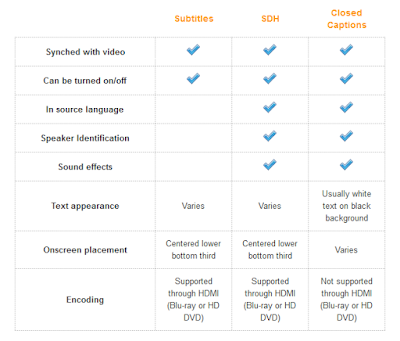As I grew up
being hearing impaired, I have always been glued to the TV but not able to
follow up with news or movies so one day when my dad came in from an outing, he
took the remote and turned on subtitle for me, I was so excited and ever since,
I have been depending on subtitles when I want to watch TV or movies because if
it is not on, then I would not be able to follow up and I will lose interest
soon after.
In Deaf
world, we cannot hear what is being said on the TV or Movies so we depend on
subtitles and it carry us along too when we are watching
along with hearing people. Thanks go to those who initiated subtitles and also
to those who have the heart to put the subtitles on TV and movies.
When I applied to Walden University for Masters, (Walden University is an
online university), I was told that I would be receiving lectures live online,
I asked myself, how am I able to follow up with what is lectured online? So I
contacted academic adviser and explained my situation to him. (In my mind, I
was thinking that I will be excluded because of the discrimination everywhere),
I got a reply from him; he said I should turn on CC that’s Closed Caption.
Since then, I have been following up with lectures like others.
The difference between closed captions and subtitles is that we also have subtitles for the deaf and hard of hearing which is known as SDH:
CLOSED CAPTIONS (CC) Closed captions are a text version of the spoken part of a television, movie, or computer presentation. Closed captioning was developed to aid hearing-impaired people, but it's useful for a variety of situations. For example, captions can be read when audio can't be heard, either because of a noisy environment, such as an airport, or because of an environment that must be kept quiet, such as a hospital.
SUBTITLES (SS)
Subtitles are intended for viewers who can hear the audio, but cannot understand the language. They communicate the spoken content but not the sound effects. They are often associated with translation; sometimes, multilingual subtitles are available.
Subtitles are intended for viewers who can hear the audio, but cannot understand the language. They communicate the spoken content but not the sound effects. They are often associated with translation; sometimes, multilingual subtitles are available.
SUBTITLES FOR THE DEAF AND
HARD-OF-HEARING (SDH)
SDH are subtitles in the source language of the video that also include important non-dialogue audio sound effects and speaker identification. While normal subtitles assume the viewer can hear the audio but do not know the spoken language, SDH assume that the viewer cannot hear the audio (like with captions). They are intended to emulate closed captions on media that does not support closed captions, such as Blu-ray.
SDH are subtitles in the source language of the video that also include important non-dialogue audio sound effects and speaker identification. While normal subtitles assume the viewer can hear the audio but do not know the spoken language, SDH assume that the viewer cannot hear the audio (like with captions). They are intended to emulate closed captions on media that does not support closed captions, such as Blu-ray.
 |
| The table culled from Lily Bond |
No comments:
Post a Comment